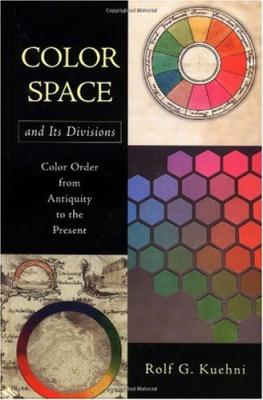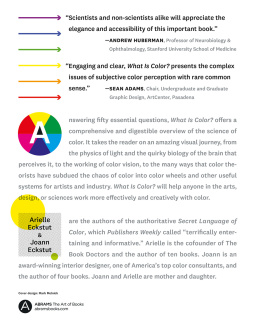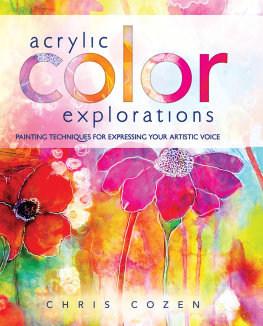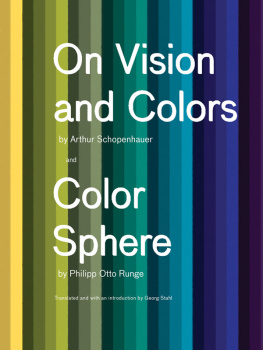Color Space and Its DivisionsColor Space and
Its Divisions
Color Order from
Antiquity to the Present
Rolf G. Kuehni
A John Wiley & Sons Publication
Copyright 2003 by John Wiley & Sons, Inc. All rights reserved.
Published by John Wiley & Sons, Inc., Hoboken, New Jersey.
Published simultaneously in Canada.
No part of this publication may be reproduced, stored in a retrieval system, or transmitted in any form or by any means, electronic, mechanical, photocopying, recording, scanning or otherwise, except as permitted under Sections 107 or 108 of the 1976 United States Copyright Act, without either the prior written permission of the Publisher, or authorization through payment of the appropriate per-copy fee to the Copyright Clearance Center, Inc., 222
Rosewood Drive, Danvers, MA 01923, 978-750-8400, fax 978-750-4470, or on the web at www.copyright.com. Requests to the Publisher for permission should be addressed to the Permissions Department, John Wiley & Sons, Inc., 111 River Street, Hoboken, NJ 07030, (201) 748-6011, fax (201) 748-6008, e-mail: permreq@wiley.com.
Limit of Liability/Disclaimer of Warranty: While the publisher and author have used their best efforts in preparing this book, they make no representations or warranties with respect to the accuracy or completeness of the contents of this book and specifically disclaim any implied warranties of merchantability or fitness for a particular purpose. No warranty may be created or extended by sales representatives or written sales materials. The advice and strategies contained herein may not be suitable for your situation. You should consult with a professional where appropriate. Neither the publisher nor author shall be liable for any loss of profit or any other commercial damages, including but not limited to special, incidental, consequential, or other damages.
For general information on our other products and services please contact our Customer Care Department within the U.S. at 877-762-2974, outside the U.S. at 317-572-3993 or fax 317-572-4002.
Wiley also publishes its books in a variety of electronic formats. Some content that appears in print, however, may not be available in electronic format.
Library of Congress Cataloging-in-Publication Data
Kuehni, Rolf G.
Color space and its divisions : color order from antiquity to the present Rolf G. Kuehni.<p>
p.
cm.
Includes index.
ISBN 0-471-32670-4 (cloth : acid-free paper)
1. Color vision.
2. Colors.
I. Title.
QP483 .K84 2003
152.145dc21
2002014045
Printed in the United States of America
To the memory of Dorothy Nickerson and David L. MacAdam, and toAndreas Brockes for their encouragement to continue the pursuit of colororder and color difference
All that is alive tends toward color, individuality, specificity, effectiveness,and opacity; all that is done with life inclines toward knowledge, abstraction,generality, transfiguration, and transparency.
Johann Wolfgang von Goethe
Contents
Preface
xii
Chapter 1. The Concept of Color Space and Color Solid
1.1
Introduction 1<p>
1.2
Divisions of Color Spaces and Solids 6<p>
1.3
Uniform and Regular Color Spaces 8<p>
1.4
Color Space, Sensation, Perception, and Awareness 15<p>
1.5
Plan of the Book 16<p>
Chapter 2. Historical Development of Color Order Systems
2.1
Color and Color Order Systems 19<p>
2.2
From Ancient Greece to the Middle Ages 21<p>
2.3
Color Order in the Renaissance 32<p>
2.4
Newtons Color Diagram 43<p>
2.5
Development of the Color Circle 46<p>
2.6
Mayer and Lamberts Color Solids 51<p>
2.7
Color Circles from Harris to Henry 55<p>
2.8
Three Primary Color Theories 59<p>
2.9
Runges Color Sphere 59<p>
2.10
The Cylindrical System of Matthias Klotz 63<p>
2.11
The Early Development of Psychophysics 63<p>
2.12
Chevreuls Hemispheric System 66<p>
2.13
Dopplers Sphere Octant 69<p>
2.14
Yellow, Red and Blue, For a Time Firmly Established as Primary Colors 69<p>
vii
viii
CONTENTS
2.15
Helmholtz, Grassmann, and Maxwell 72<p>
2.16
Hering 75<p>
2.17
Geometrical Systems of the Nineteenth Century 78<p>
2.18
The Nineteenth-Century Experimental Psychologists 82<p>
2.19
The Munsell System 84<p>
2.20
Ridgeways Color Atlas 86<p>
2.21
Ostwalds Farbkrper (Color Solid) 89<p>
2.22
Geometrical Systems of the Twentieth Century 90<p>
2.23
Rsch-MacAdam Color Solid 91<p>
2.24
The Luther-Nyberg Color Solid 93<p>
2.25
The German DIN6164 System 93<p>
2.26
Optical Society of America Uniform Color Scales 95<p>
2.27
Swedish Natural Color System 96<p>
2.28
Universal Color Language 98<p>
2.29
Color Mixing Spaces 100<p>
2.30
Spectral Spaces 101<p>
Chapter 3. Psychophysics
3.1
Fundaments of Psychophysics 105<p>
3.2
Categories 108<p>
3.3
Differences versus Magnitudes 109<p>
3.4
Psychophysical Scaling: Levels of Measurement 113<p>
3.5
Scaling Methods 116<p>
3.6
Unidimensional Scaling Methods 117<p>
3.7
Psychometric Function 119<p>
3.8
Multidimensional Scaling 119<p>
3.9
Psychological and Psychophysical Spaces 121<p>
3.10
Psychophysical Scaling as a Basis of Color Space 122<p>
Chapter 4. Color Attributes and Perceptual Attribute Scaling
4.1
Theories of Vision 123<p>
4.2
Historical Development of Views on Attributes 124<p>
4.3
Whiteness and Blackness 129<p>
4.4
Evanss Five Color Attributes 131<p>
4.5
Common Color Attribute Definitions 132<p>
4.6
Confirmation of Three Attributes 134<p>
4.7
Contrast versus Similitude 137<p>
4.8
Neural Correlates of Color Attributes 137<p>
4.9
Psychological (Perceptual) Scaling of Color Attributes 138<p>
4.10
Perception of Color Differences 154<p>
CONTENTS
ix
Chapter 5. Psychophysical Scaling of Color Attributes:Stimulus and Perception
5.1
Requirements for a Uniform Psychophysical Color Space 157<p>
5.2
Postulated Relationship between Psychological and Physical Magnitudes 158<p>
5.3
Photometry and Brightness/Lightness 159<p>
5.4
The Colorimetric System 161<p>
5.5
Cone Response Space 164<p>
5.6
Opponent Color Space 169<p>
5.7
How Are the L, M, S and X, Y, Z Color Spaces Related?
Next page 








